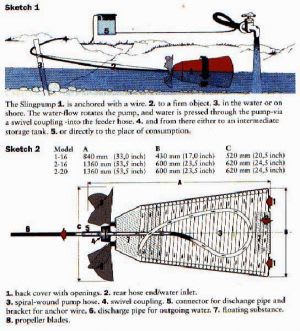Hello Hivemind!
I better admit it at once, I am not an engineer but a natural science researcher working in agriculture. So bear with me.
I am working in developing countries where limitations are often people's constant companion. Water for small scale irrigation for vegetable gardens or for livestock keeping is often a problem, even though rivers are sometimes nearby. Electricity is expensive, as is fuel, often to a degree that is prohibitive for smallholder activities.
So I would like to build a sling pump from locally available materials, such as buckets, hoses, and tubes. While I have a general design idea already, I have difficulties to find information on the effect of different variables in such a simple system. Given that river banks are often high (10 or more meters) pressure head is one of the most important variables for me but I was not able to find specific information so far. I am here in the hope that someone can fill the gaps in my knowledge.
What effects I have identified so far:
------------------------------Pressure------Discharge
More coils----------------------up-------------NE
Submerge ratio----------------NE-------------up (to max.)
Rotational speed---------------NE-------------up
Bigger intake pipe diameter----?-------------up
Coil diameter--------------------?--------------?
*NE - No effect
Also, it is unclear to me if it makes a difference whether the supply-pipe on the other side of the rotary joint that connects the pump to the tank has a different diameter from the coil pipe in the pump.
I would be very happy if somebody could elucidate.
In case you want to get an idea of how the pump I have in mind would look like...
I plan to use a 216 liter (90x65cm) bucket in the shape of a truncated cone. The inside of the bucket will be lined with an irrigation hose (16 or 12 mm ID). The end of this hose gets connected to a rotary joint that sits at the bottom center of the bucket. A propeller is mounted to the same side to keep the bucket rotating. That's basically it.
Thanks a lot for your help.
I better admit it at once, I am not an engineer but a natural science researcher working in agriculture. So bear with me.
I am working in developing countries where limitations are often people's constant companion. Water for small scale irrigation for vegetable gardens or for livestock keeping is often a problem, even though rivers are sometimes nearby. Electricity is expensive, as is fuel, often to a degree that is prohibitive for smallholder activities.
So I would like to build a sling pump from locally available materials, such as buckets, hoses, and tubes. While I have a general design idea already, I have difficulties to find information on the effect of different variables in such a simple system. Given that river banks are often high (10 or more meters) pressure head is one of the most important variables for me but I was not able to find specific information so far. I am here in the hope that someone can fill the gaps in my knowledge.
What effects I have identified so far:
------------------------------Pressure------Discharge
More coils----------------------up-------------NE
Submerge ratio----------------NE-------------up (to max.)
Rotational speed---------------NE-------------up
Bigger intake pipe diameter----?-------------up
Coil diameter--------------------?--------------?
*NE - No effect
Also, it is unclear to me if it makes a difference whether the supply-pipe on the other side of the rotary joint that connects the pump to the tank has a different diameter from the coil pipe in the pump.
I would be very happy if somebody could elucidate.
In case you want to get an idea of how the pump I have in mind would look like...
I plan to use a 216 liter (90x65cm) bucket in the shape of a truncated cone. The inside of the bucket will be lined with an irrigation hose (16 or 12 mm ID). The end of this hose gets connected to a rotary joint that sits at the bottom center of the bucket. A propeller is mounted to the same side to keep the bucket rotating. That's basically it.
Thanks a lot for your help.

